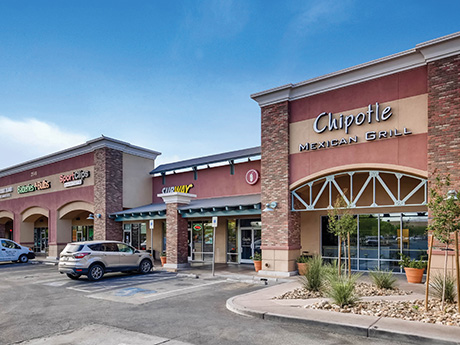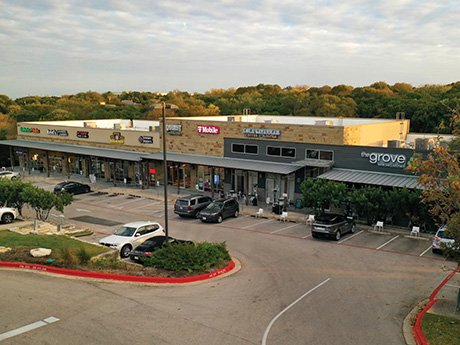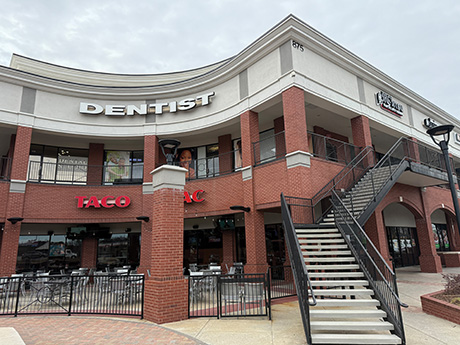Boasting strong, steady real estate fundamentals, unanchored shopping centers remain in high demand — but good luck finding available product to acquire.
Investment sales for anchored and unanchored open-air centers remain strong — thanks to their unwavering, stable fundamentals. What makes open-air strips a desirable property type is they are both recession-proof and internet-proof — meaning people will always need the product or service, and they can’t get it online. Rob Holuba, managing director of CenterSquare Investment Management, has a name for these irreplaceable spaces: Essential Service Retail (ESR).
In fact, you might call them the ‘essential workers’ of retail.
These properties typically range between 20,000 and 40,000 square feet, feature no anchor, have small suite sizes that average less than 2,000 square feet and can cater to a wide array of different tenants. ESR properties have excellent visibility and are typically located at a hard corner or highway intersection that benefits from outsized traffic counts.
“CenterSquare is solely focused on investing in unanchored open-air centers,” Holuba says. “We prefer this type of retail because it has less institutional competition and anchor tenants typically have flat rents with multiple fixed-rate options, so it is very difficult to grow your income over the hold period.”
In 2024, CenterSquare acquired 13 shopping centers across Atlanta, Salt Lake City, Houston, Charlotte, Austin, Las Vegas and Phoenix that met this criteria. In May 2024, the company acquired Ogden Commons, a 19,723-square-foot property located in Ogden, Utah. This transaction marked its debut ESR investment within the Salt Lake City MSA. Located just 30 minutes from Salt Lake City, the property is 100 percent leased to a diverse array of national tenants spanning a variety of complementary uses, and each of the three buildings at Ogden Commons includes a wrap-around drive-thru.

Unanchored strip centers have been a strategic focus of Crow Holdings for the past decade. In fact, Crow has been so drawn to this space that it has aggregated one of the largest unanchored strip portfolios in the country. According to its director, Kristen Neyland, Crow currently owns approximately 200 assets across 30 states valued at over $2.5 billion and growing.
“Retail is the product type that relies the most on true real estate fundamentals: a hard corner, access, visibility, signage, demand driver, tenant suite size,” she says. “Everyone talks about logistics and industrial and all those trends that drive that, but it’s really those exact same trends that are driving convenience-based retail. Those are a few of the fundamentals we look at when evaluating a new deal, because of the necessity-based nature of the product.”
Convenience is another key driver, says Christian Chamblee, a partner with Ziff Real Estate Partners. “To us, one of the most important fundamentals — and one that ultimately leads to the popularity and success of open-air centers — is convenience. When a center is convenient and visible, from there, the landlord can layer in other important elements for success such as inviting aesthetics and features for furthering length of stay and cross shopping.” (According to a study by Pathintelligence, increasing dwell time by just 1 percent leads to an average 1.3 percent increase in sales.)
In 2025, Ziff acquired Village Square Shopping Center in Louisville, Colorado, just outside Boulder. This asset is a 40,000-square-foot unanchored strip center with 15 tenant suites. There are 50,000 people within 3 miles and the average household income is over $130,000 annually. Another recent Ziff acquisition is Hilliard Square Shopping Center near Columbus, Ohio. The center is shadow anchored by Kroger and contains 24 tenant suites over 53,000 square feet. Ziff also buys larger format assets, such as Promenade at Northwoods, a 253,000-square-foot multi-anchored shopping center in North Charleston, South Carolina, near the company’s Charleston headquarters.
With all that it has going for it — necessity, visibility, convenience — it’s no wonder the unanchored strip center space is as popular as ever. But finding available space to acquire is another issue entirely. This scarcity, however, helps to keep small shop retail fundamentals strong.
“There has been limited supply added to the retail stock over the last decade while tenant demand has stayed elevated,” says Marco Macali with Northpond Partners. “With the limited supply and strong demand, rental rates have pushed higher and the occupancy rate nationwide is around 95 percent.”
Adds Ron Chanin of Riverwood Properties: “These products are likely the strongest of investment types for several reasons. First, they are typically well located. Secondly, the space sizes allow for ready replacement. With a tenant mix of restaurants, exercise, medical and service, this product is desirable to investors.”
The types of owners actively looking to buy open-air centers are across the board: private, institutional, public REIT and more.
“We are seeing historic interest in unanchored retail centers that I haven’t seen in two and a half decades of brokering these properties,” says Jeff Enck, first vice president of Matthews Real Estate Investment Services, a brokerage firm primarily focused on unanchored strip centers. “Interest is particularly strong from large private funds from across the country in particular, with some true institutional REITs entering the space as well. For B-C class strip centers, we are seeing activity from the traditional private investors and 1031 exchange buyers.”
Less available product does means fewer choices. Some firms, such as Matthews, Riverwood and Ziff, view finding properties as a challenging, sometimes painstaking, process. Others, such as Northpond Partners, say that finding properties is the easy part — the hard part is engaging with the owner to acquire the property from them. Northpond seeks high-quality, well-located stabilized unanchored neighborhood shopping centers, typically in dense, infill submarkets in top markets. Safeway Group seeks primarily value-add shopping centers. Then there is CenterSquare, which has such a selective, specific process when seeking properties for acquisition that the scarcity benefits its ability to narrow down available options.
“There is currently a large surplus of cash seeking quality strip centers with sound intrinsics,” says Enck. “This is making acquisitions more and more difficult, though we do expect the looming abundance of loan maturities at record low rates to help reset the market and increase velocity over the next six to 24 months.”
Buyers are willing — just not always able. “Currently there is a tremendous lack of available product,” says Chanin. “There is certainly a great deal of money on the sidelines.”
With such economic challenges, firms offer varying strategies for acquisition. To start with, see what — if anything — is available. For his part, Rafat Shaikh with Safeway Group doesn’t find it difficult to find the right properties. “I know what makes a good shopping center and a bad shopping center because I have been doing this for over 40 years now,” he says. Then decide, is it priced right? Chanin cautions that many of today’s centers have inflated price tags.
“We continue to look at available centers,” he says. “But centers are generally overpriced. Owners are taking advantage of a lack of properties for sale and placing less quality centers for sale. Many of these centers are C and D centers but are being priced at A prices. I am not interested in overpaying for centers nor am I interested in purchasing centers with significant issues.”

Others say, if you can find unanchored centers, now is the time to buy. “Now is a good time to acquire properties because retail fundamentals are strong,” Macali says. “Demand for retail space is high while supply has remained limited. Occupancy rates nationwide are 95 percent and rent growth has remained strong over the past five years.”
Unanchored space can almost always weather the ups and downs of the market, too. “We have been in acquisitions mode during multiple economic cycles, with various market factors,” says Chamblee. “Right now a major factor making the acquisition market attractive is supply. 70 percent of all retail product built since the great financial crisis has been single tenant net lease.”
The COVID-19 pandemic has also left its mark. Enck explains how the shopping habits of consumers have shifted toward service and convenience retail post-COVID — keeping unanchored strips strong and attractive. “Investment groups are coming to understand that shopping centers do not need a large anchor to draw traffic and that local mom-and-pop type tenants in many cases perform better than corporate tenants,” Enck says. “In addition, small retail spaces are in high demand, so re-leasing space when a tenant vacates now represents an opportunity to backfill with potentially stronger operators at higher rents. The funds and institutions are seeking for yield unachievable in many of the other traditionally sought after property types such as multifamily, industrial and grocery anchored retail.”
Neyland has had a similar experience. “We are firm believers in mom-and-pops. If you think about the top national tenants today — Starbucks, Chipotle, Jimmy John’s — those all started out as neighborhood restaurants,” she says. “Some of our worst actors during COVID were the corporate credit tenants, which we still remember. We really saw a lot more transparency and communication and collaboration from our regional and local tenants.”
Crow Holdings has been committed to retail from the very beginning, Neyland says. “Our founder, Trammell Crow, was a very firm believer that real estate is a tenant-driven business, and he’s not wrong. So when our CEO, Bob McClain, got his start, he started out leasing, and he started out in this product space, in the small shop space. Bob was quickly able to identify the many positive attributes associated with this strategy, the main one being how quickly it leases. So we refer to this product type as the ‘multifamily of retail’ — when one tenant leaves, you just sweep the floor, change the locks, turn it over to another tenant, and go on.
“So when it came time for Crow to offer our investors a sidecar fund for the first time, it was really a no-brainer. It was simple: we wanted to focus on these strip centers and leverage our 30 years operating in this space. The product was institutional in every aspect but size and the concept was simple enough for all of our kids to understand — you can’t get your hair cut and your nails done on the internet. And if your iPhone breaks, you’re probably going to walk into the iPhone repair place and get it fixed, even when times are tough. So that’s how it started.”
When times are tough or retail space is tight, tenant mix is vitally important through it all. As Chanin explains, Riverwood typically looks at the tenant mix and the quality of the tenants and sees how it can create upside. The goal is to do more with less: create a strong tenant mix, even with less space available.
Tenant mix is crucial for CenterSquare and Northpond Partners, too, particularly in a tight market. Both firms concentrate on essential service categories, including food & beverage; service-oriented business such as beauty salons, nail salons or barbershops; medical tenants; and other internet-resistant uses.
“A shopping center needs tenants that cater to the neighborhood,” says Northpond’s Macali.
Chanin says the proper tenant mix can “make or break” a center. “In one center during COVID, we lost a tenant and replaced with two national tenants,” he says. “Although there was buildout, we created significant value. I have since been successful in doing this multiple times. Quality centers draw quality tenants. It is important not to just lease a space but to lease a space to a quality tenant for your center.”

As Neyland puts it, Crow Holdings “likes credit just like anybody else does,” but the company does recognize the value in local and regional tenants as well. “We know that the tenant mix in our center is super important, for it to be operating well,” she says. “Across our portfolio, we have one-third tenancy that’s corporate, one-third that’s regional, and one-third that’s local. And look, people like local flair. Not just corporate chains. If you think about Goldberg’s or Willy’s, local tenants here in Atlanta, they’re household names. People keep going back to them. Also what we love about mom-and-pops is that there’s communication and there’s transparency. These are family businesses that are paying for their kids to go to school, they are helping pay their mortgage. The decisions for these businesses are being made at the dinner table at night and not in corporate board rooms, which is super helpful for landlords also.”
Tenant mix is also critically important to driving traffic and, optimally, to spread customer visits across different times of day. “With overall occupancy at 95 percent-plus, this becomes more challenging, but the upside is that with the historically strong retail market that we are in currently, many tenants that would be borderline successful businesses in the past are performing well,” Enck explains. “Occasionally, we are seeing landlords offer buyouts to tenants to vacate if they have a significantly better tenant use, but the numbers have to work. More commonly, owners of strip centers are waiting tenants out to the end of their leases. We are also seeing these landlords be more reluctant to offer tenant options with their new leases and renewals.”
Several of Matthews’ notable transactions over the last quarter include Winco Center in Clearwater, Florida; Keith Street Plaza in Cleveland, Tennessee; Shops at Chateau Elan in Hoschton, Georgia; Canterbury Shops in Rock Hill, South Carolina; Wade Hampton Shops in Greenville, South Carolina; Ole Mill Village in Jefferson, Georgia; and District at Freedom Town Center in Fayetteville, North Carolina.
“We have a good pipeline of opportunities moving forward, though lack of sellers is limiting the overall velocity right now,” Enck says.
Although thorough merchandising and screening is a must-have core competency for any owner, it is a luxury right now to have the ability to be choosy in adding new tenants. “To our neighborhood centers, we hope, early on, to attract interesting restaurants who will draw in the locals of the suburbs that we serve,” says Chamblee. “Often, we are lucky enough to have these in place at acquisition. Becoming the heart of the neighborhood is the goal with smaller format centers. It is important to remember that the members of our organization are all shoppers and patrons, so we should ask ourselves what would draw us in, make us stay for a while; what goods and experiences are worth the spend of our hard-earned dollars.”
Shifting consumer behaviors, especially in the wake of COVID, have impacted leasing decisions and long-term planning for many of these centers. According to Holuba at CenterSquare, consumers have been changing how they shop — more online — and what they shop for: consumption of experiences and services rather than goods. “Essential Service Retail is the intersection of these two megatrends,” he says. “We have e-commerce resistant tenants (think haircuts and dentists), whose customers have to visit the store in order to consume the service.”
Macali agrees: “Since internet penetration of retail has increased over the last decade, there has been a focus on finding tenants that provide necessary services or foodservice that cannot be done on the internet.”
As Chanin chimes in: “Consumers still go the restaurants, exercise facilities and medical facilities. Online shopping has not really affected that.”
It all comes down to finding the right — essential — real estate. “Essential Service Retail is all about convenience, so we look to acquire rectangles on highly trafficked roads, with over 30,000 vehicles per day, great visibility, plenty of parking, easy access, in dense and/or affluent suburban submarkets,” says Holuba.
“Customers visit our centers to grab a quick lunch, see their dentist, get a haircut. On average, our customer in onsite for less than 10 minutes, but will make multiple visits per month as they run everyday errands.”
By definition, everyday errands are essential and cannot be replicated online. And, as Neyland reminds us, “You can’t get your hair cut and your nails done on the internet.” Some things really do need to be in-person. Unanchored strip centers will always be here to answer the call.
— Katie Lee
This article originally appeared in the March 2025 issue of Shopping Center Business magazine.

